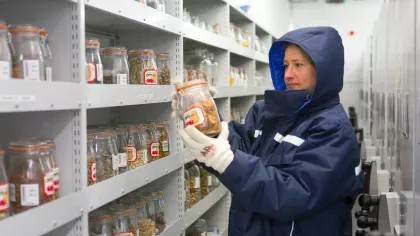11 November 2023
Every seed has a story
Delve into the Millennium Seed Bank vaults with us and uncover the secrets behind some of our seeds.

Safely stored in the Millennium Seed Bank at Wakehurst are over 2.4 billion seeds, from 40,000 different species and 190 countries and territories worldwide.
We’ve hand-selected a few to celebrate what makes them unique and a valuable addition to our global collection.
Arctic starflower (Lysimachia europaea)
The Arctic is on the front line of climate change, experiencing more rapid warming than other areas of the planet.
So, it’s vital we bank seeds from species currently growing in this region. Not only does this protect them from extinction, but we can also study them to understand how they will fare against climate change.
During a seed-collecting mission in Arctic Sweden, our scientists were drawn to the seed capsule of the Arctic starflower, due to its resemblance to a football.


Fonio (Digitaria exilis)
Fonio is a neglected and underutilised crop species, cultivated across West Africa and grown using mostly traditional methods, meaning it is crucial to cultural identities and local food systems.
The crop is incredibly drought tolerant and will be vital in maintaining robust food security across arid Sub-Saharan agricultural regions in the future.
Fonio has been the focus of several Kew projects, including a seed-collecting trip to Guinea in autumn 2022, which is prime fonio harvesting season.


Dwarf birch (Betula nana)
Dwarf birch is rare, a relic of the glacial period, that's only found at high altitudes or latitudes – and it’s under threat.
The burning of moorlands in the UK is resulting in habitat loss; grazing animals affect seed production; and the Dwarf birch’s preference for cool, wet climates is challenged by global warming and climate change.
Early this year, our UK Tree Seed Collecting team ventured up to Rannoch Moor in the Scottish Highlands to collect the tiny, wind-dispersed seeds of the Dwarf birch. The seeds were then sent back to the Millennium Seed Bank, becoming the most southerly UK collection of this species.
Due to its reliance on cooler alpine climates, this population of Dwarf birch is potentially the most at risk from global warming.


Pasqueflower (Pulsatilla vulgaris)
Classified as Near Threatened due to the loss of its native chalk grassland habitat, pasqueflower is widely cultivated across Europe.
Its rare flowers bloom in a kaleidoscope of colours, and it's often seen as a symbol of rebirth in historical battlegrounds.
One legend tells that pasqueflowers sprang up in places that had been soaked by the blood of Romans or Danes, as they often appear on old barrows and boundary banks. In fact, it's more likely that these sites are favoured by the perennial pasqueflower as they tend to be undisturbed chalk grassland – its habitat of choice.
Pasqueflower has been identified as one of the UK's most threatened species, calling for conservation action. We carried out a seed collection last spring, with seeds now stored safely in the Millennium Seed Bank at Wakehurst.

Moodjar (Nuytsia floribunda)
The flowering of moodjar’s brightly coloured clusters coincide with the Christmas season, resulting in its nickname of Western Australian Christmas tree.
Its scientific name derives from the Latin floribundus, meaning profusely flowering, with bright yellow and orange flowers adorning its impressive 12-metre maximum height.
Moodjar is the world’s largest root parasite, stealing water and nutrients from the roots of host plants. It’s been reported that plants up to 150 metres away from Moodjar may be parasitised.
Seeds of this species, from southwest Australia, are housed in the Millennium Seed Bank. They were collected in the Stirling Range National Park, Western Australia, where some moodjar plants came back to life after a bushfire.


Mountain houseleek (Sempervivum montanum subspecies stiriacum)
Found only in the alpine Styria region of Southwestern Austria, mountain houseleek is a small perennial plant with small clusters of pink flowers and rosettes of dense leaves, forming in between rocks.
Mountain houseleek seeds, which are dispersed by the wind, were recently collected in autumn.
Our scientists discovered their exceptional hardiness, as they had to microwave herbarium specimens before mounting them to prevent sprouting in the cupboards!


Psydrax sambiranensis
Last collected in January 2022, Psydrax sambiranensis is Critically Endangered and not currently within any protected areas.
The collection was made by Kew Madagascar Conservation Centre (KMCC) MSB Project Leaders Vonona Randrianasolo and Mamy Andriamahay, from partners Silo National des Graines Forestières (SNGF). The main collection is held in Madagascar, and some seeds were also taken back to the Millennium Seed Bank.
Successfully germinated seedlings joined the trial of the Critically Endangered Species pipeline project, and two seedlings are now successfully growing at Wakehurst, carefully nurtured by Botanical Horticulturalist Alice Livingstone in the MSB Nursery team.


Our global collection of seeds continues to grow. Stop by the Millennium Seed Bank on your next visit to Wakehurst to find out how we’re studying, preserving and protecting seeds from across the world.



